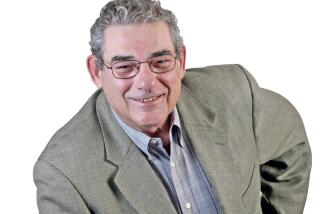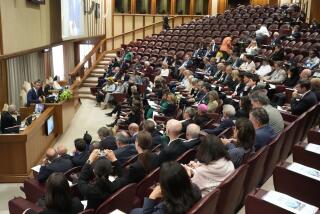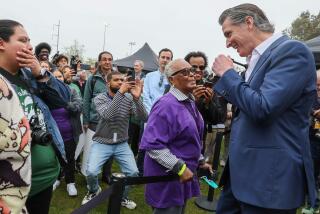Seeing Conflict, Not Celebration, in Denver Visit : Media focus on disagreements between the Pope and U.S. Catholics colored the coverage of World Youth Day and John Paul II’s first meeting with President Clinton.
- Share via
“Is the Catholic Church in America coming together or is it coming apart?”
That was Ted Koppel’s lead-in to “Nightline” when Pope John Paul II arrived in Denver for World Youth Day in 1993. Koppel and his guests then explored dissent in the Catholic Church over such issues as abortion, artificial contraception, homosexuality, priestly celibacy and the ordination of women.
Koppel’s program was typical of early media coverage of the Pope’s visit to Denver, even though--as Father Andrew Greeley told Koppel on the air--”The notion that there’s a crisis in the church is simply not true.”
Greeley--an author, sociologist and frequent critic of the Vatican--said that most of the issues that Koppel and various activist groups were discussing were “not salient for the life of ordinary American Catholics.”
Much coverage did shift from these issues to the actual events in Denver once World Youth Day activities began. But until then, most of the media seemed almost obsessed with conflict--with the anticipated confrontation between the Pope and his American flock, whom he presumably would chastise for their dissent from church teachings.
This predisposition dominated coverage of the Pope’s exchange with President Clinton when they arrived in Denver.
This was the first meeting between the Pope, a fierce opponent of abortion, and the President, who supports abortion rights. Given these polar positions, their exchange could have been truly confrontational. Instead, the Pope briefly restated his long-held and well-known views, and the President did not respond. Then the two leaders had a 45-minute private meeting that was described as amicable and during which they agreed on many international issues.
But because the Pope told the President--and America--to “defend life” and because he said, “All the great causes that are yours today will have meaning only to the extent that you guarantee the right to live and protect the human person,” most reporters decided that their expectations of a Pope-President shootout at the O.K. Corral had been fulfilled.
The Chicago Sun-Times began its story, “Pope John Paul II gave President Clinton and other Americans a tongue-lashing on abortion as he arrived in the United States on Thursday.” Newspapers in New York, Washington, Dallas, Charlotte, San Diego, Houston and dozens of other cities also emphasized the “confrontation” between the Pope and the President. The CBS and NBC evening news programs took the same approach.
The Los Angeles Times was almost alone among major newspapers in not playing up the abortion angle in its report. Not in its first edition anyway.
“There was nothing new about it,” says Times Rome correspondent William Montalbano, who was traveling with the Pope in Denver.
Thus, Montalbano began his first-edition story by noting that the Pope had “urged the United States to rededicate itself to its founding principles as leader of an international crusade for human rights and ‘authentic freedom.’ ” Only at the end of his second paragraph did Montalbano mention that the Pope “stressed his opposition to abortion in contrast to Clinton’s oft-stated views.”
But Montalbano’s editors in Los Angeles thought the differences between the two men on abortion was the “more compelling” story, and he says he was suddenly besieged by “hot- and cold-running editors” who wanted his story to reflect that.
For the next edition, Montalbano rewrote his story; his new first paragraph said the Pope “stressed the ‘right to life’ to a young President who backs abortion rights.”
Montalbano, who still thought the Pope’s comments were “no big deal,” followed that statement by pointing out, “but the two found common ground on a range of other social and international issues,” and a few paragraphs later, he made another effort to keep the story in perspective. He wrote:
“The Pope’s references to abortion Thursday were indirect, non-confrontational and broke no new ground.”
While the Los Angeles Times had different emphases in different editions on one World Youth Day story, the New York Times had different emphases from two different reporters on multiple World Youth Day stories.
Peter Steinfels, then the national religion reporter for the New York Times, says he and Alan Cowell, then the paper’s Rome correspondent, wrote stories that week that were “at odds with each other.”
Like most American reporters, Cowell paid considerable attention in his Denver coverage to abortion, birth control and other sexual issues on which many American Catholics dissent. Steinfels, widely regarded as the best religion reporter in the country, says he tried, “to no avail,” to persuade Cowell that his interpretation of the Pope’s visit was wrong.
“I saw the whole thing as more of a religious, spiritual event than he did,” says Steinfels, now on leave from the Times. (Cowell, who has since become his paper’s Bonn correspondent, declined to be interviewed for this story.)
*
In his columns and news analysis stories, Steinfels tried to explain why 187,000 young people from more than 70 nations came to see the Pope in Denver and why most Catholics everywhere continue to admire him, even if many of them strongly disagree with him on some issues.
“He is not a leader whose marching orders they await but a repository of what they value and hope for,” he wrote in one story.
A week later, in his Saturday “Beliefs” column, Steinfels criticized the news media for recounting “in some cases, a bit breathlessly, the fact that many American Catholics disagree with their church’s official teachings on birth control, ordaining women to the priesthood and other questions about sex and roles for women.”
Although agreeing that this was “a legitimate story . . . part of the essential background to Pope John Paul’s latest visit,” Steinfels complained that those topics “came to dominate the foreground as well (and) much about the Pope’s visit and his message was obscured.”
This was typical of how the media generally cover the Pope. Too often, as Greeley says, the media are more interested in entertaining than in informing, so not only do they concentrate on sexual issues but instead of interviewing people who have “insight and understanding,” they choose predictable extremists who contribute little of substance to what could and should be a provocative and enlightening public dialogue. The resulting stories--as in Denver--are often more caricature than coverage, especially on television.
“Even national, reputable newspapers all too easily settle for superficial, stereotypical coverage,” says Joe Atkins, an assistant professor of journalism at the University of Mississippi, in his study of reportage on World Youth Day.
Too often, he wrote, the media “allow preconceived notions and personal prejudices to further taint that coverage, and participate in a trivialization and politicization of an event that for many, or most, of its participants held meaning and depth far beyond the reach of politics.”
Atkins’ primary criticism of media coverage was its emphasis on what other critics have called the “predetermined agenda” of “conservative Pope chastises dissenting liberal flock.” But he also complained that many news organizations compared the youthful outpouring in Denver to the Woodstock rock music festival in 1968, even though Woodstock was “in many ways . . . the very symbol of the self-indulgence and licentiousness that Pope John Paul II opposes.”
In his study, Atkins singled out Steinfels for praise, although he noted that even one of the reporter’s “thoughtful, probing” articles carried the headline (not written by him):
“Morality Debates Don’t Rain Out the Pope’s Woodstock.”
More to Read
Sign up for Essential California
The most important California stories and recommendations in your inbox every morning.
You may occasionally receive promotional content from the Los Angeles Times.










